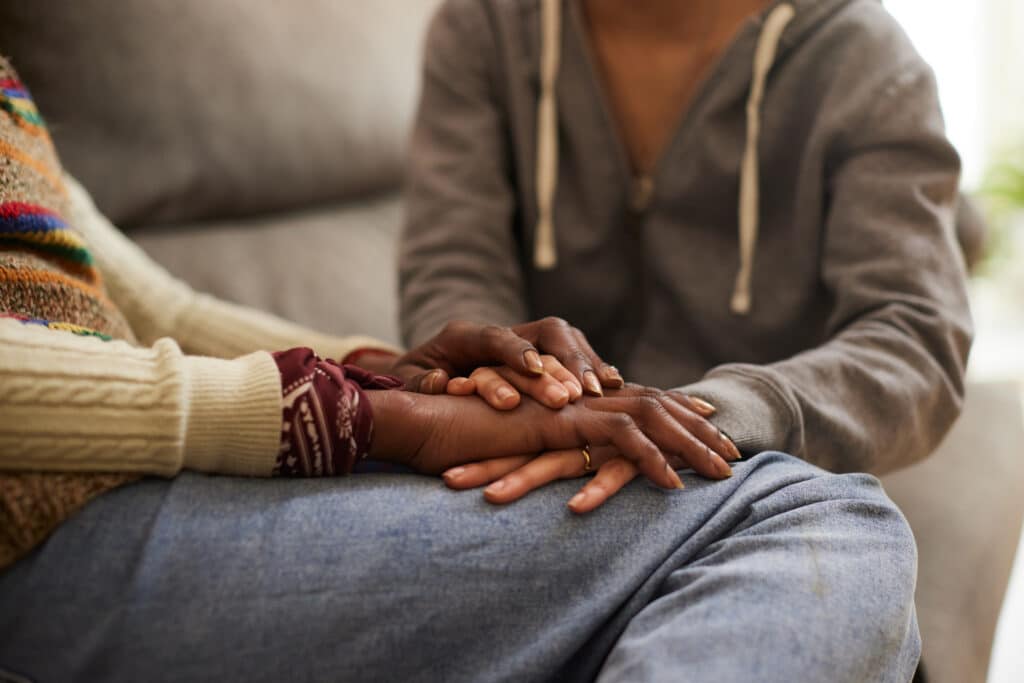Complex trauma can be a heavy and often misunderstood experience, affecting many aspects of life, especially when trauma is experienced in childhood. Unlike typical trauma, it stems from long-term, repeated emotional or physical abuse, often from someone in a trusted position, and can cause deep, lasting changes in a person’s identity and relationships.
The effects can be overwhelming, leaving survivors feeling disconnected or stuck in unhealthy emotional patterns. But healing is possible.
In this blog post, we’ll help you understand the symptoms and impact of complex trauma and explore the steps to recovery.
What is Complex Trauma?
Complex trauma is a term used for repeated, chronic emotional pain or abuse, often suffered in childhood or adolescence. It can cause long-term problems that are similar in some ways, but distinct in others, from post-traumatic stress disorder (PTSD), and also from “regular” trauma.
Such trauma may come in the form of emotional, physical, and/or sexual abuse and may be perpetrated by a caretaker. Some may even get hit with a double dose of abuse, including bullying, both in the home and again at school via bullying, leaving a survivor doubly traumatized.

What Are Common Complex Trauma Symptoms?
Complex trauma can affect every part of your life, from your emotions to your relationships. It often stems from long-term, repeated exposure to traumatic events or abuse, which can make it hard to cope with everyday situations.
Here’s a closer look at some common symptoms of complex trauma, what they might look like in real life, and how they can show up in you or someone you care about.
1. Difficulty Managing Emotional Responses
When you’ve been through complex trauma, it’s common to have a hard time managing your emotions. You might feel angry, sad, or overwhelmed, and it can seem like you have no control over these feelings.
It could look like sudden outbursts of anger over small things, or feeling like a wave of sadness comes out of nowhere. You might also have trouble shaking negative thoughts or even experiencing suicidal thoughts or passive suicidal ideation.
These emotional responses often happen because your mind is still reacting to past trauma, even if you’re no longer in danger. These emotions feel bigger than the situation because they’re tied to deep, unresolved pain.
It’s important to know that these feelings don’t mean something’s wrong with you — they’re your brain’s way of protecting you from more hurt.
2. Detachment
Detachment is when you feel disconnected from the world around you or even from yourself. This might show up as dissociation, where you “check out” mentally, or have moments where you feel like you’re watching yourself from the outside.
For example, you might suddenly forget what happened during part of your day, or feel like you’re not really “there” when talking to someone. This happens because your brain is trying to protect you from overwhelming feelings by detaching from the reality of the moment.
It’s like your mind is giving you a break from the pain, but it can leave you feeling numb or distant. If this happens often, it can make it harder to be present with others or even with yourself, but recognizing it is the first step toward grounding yourself in the present.
3. Negative Self-Image, Shame, and Guilt
A big part of complex trauma is struggling with how you see yourself. You might feel deep shame or guilt about things that weren’t your fault. For example, you might think “I’m broken” or “I don’t deserve happiness” even though those thoughts aren’t true.
This negative self-image can stem from years of being told, directly or indirectly, that you weren’t good enough. If you were abused or mistreated, your mind may have connected that treatment to your worth as a person.
It’s important to understand that your value isn’t determined by what others have done to you and that rebuilding a positive self-image is possible with time, patience, and support.

4. Trouble with Relationships
Trauma can make relationships feel difficult or even unsafe. If others have hurt you in the past, it can be hard to trust anyone, even those who care about you.
You might pull away from loved ones, pushing people out even when you need them most. This might look like isolating yourself from friends or family, or avoiding social situations because you don’t feel like you can trust anyone.
The fear of being hurt again can make it hard to connect with others, and this lack of trust can keep you from having the support you need to heal. But it’s important to recognize this as a response to past pain, not a reflection of who you are. With the right help, you can learn to trust again and build healthy relationships that support your recovery.
5. Unhealthy Fixation On the Abuser
Sometimes, when trauma is unresolved, it can lead to an unhealthy fixation on the person who caused the harm. This might look like constantly thinking about the abuser, wondering why they did what they did, or feeling emotionally attached to them, even though you know it was a toxic relationship.
Fixation happens because your brain is still trying to make sense of what happened, and sometimes, it holds onto the past in a way that makes it hard to move forward. Even though these thoughts may seem like they’re holding you back, they’re a normal reaction to trauma.
The goal isn’t to blame yourself but to understand that these thoughts are part of the healing process, and you can work through them with the right support.
6. Loss of Religion and Other Beliefs
If you’ve been through complex trauma, it can shake your sense of belief or faith. You might question things you once believed in, like religion or core values. For example, you might ask, “How could this happen if there’s a higher power?” or feel disconnected from spiritual practices that once comforted you.
This can feel like losing a part of yourself or your foundation, leaving you uncertain or lost. But it’s common for trauma to cause doubt and confusion. Over time, with support and healing, you can rebuild your beliefs or find new ones that fit who you are now.
7. Sense of Hopelessness
Finally, one of the hardest symptoms of complex trauma is a deep sense of hopelessness. It can feel like nothing will ever get better, or that you’re stuck in a cycle that you can’t escape.
You might think, “What’s the point of trying?” or “Things will never change.” This feeling can leave you feeling stuck, like you don’t have control over your life.
However, recognizing that hopelessness is part of the trauma response is key. It doesn’t have to define you, and with the right support, you can break out of this mindset. Healing is possible, even when things seem dark.

Three Phases of Complex Trauma Recovery
Harvard psychiatrist Judith Herman developed the C-PTSD diagnosis, as well as a model of the three phases of recovery from complex or severe trauma. Her steps for overcoming trauma are shared in Psychology in the Real World’s writing collection and summarized here:
Stage 1
This is where you get an overview of the recovery process, making sure you’re in a safe and stable place physically and relationally. You’re learning how to regulate emotions and preparing mentally for recovery, including preparing to reencounter damaging memories.
It’s important here to begin identifying destructive patterns of behavior and learn to respond differently. It’s vital not to begin engaging traumatic memories until stage two.
Stage 2
This stage moves into dealing with difficult memories and the emotions and reactions they stir up. You’re working through grief from unwanted or abusive experiences and also grieving positive experiences you missed out on.
Memory processing can be accomplished through traditional talk therapy, as well as newer techniques like eye movement desensitization and reprocessing (EMDR). This is a process that can be effective at ending the influence of memories in your daily life using alternating side-to-side stimulation of a sense using lights, gently-vibrating paddles held in each hand, or sounds, which we experience while accessing traumatic memories.
The treatment can help dissolve the sharp bodily or emotional reactions to the trauma. Antidepressants may also be prescribed to complement therapy.
Stage 3
Finally, this is the step where your energies are focused on reestablishing healthy relationships and reengaging with a normal routine of life and activities from which trauma kept you disconnected.
Start Healing from Complex Trauma
Because of its severity and time frame of taking place most often in childhood or adolescence, complex trauma recovery can be challenging. However, there are proven techniques for helping patients heal and move on from it.
Finding support, both in the form of a treatment program or therapist and supporting network of friends and family, can help struggling patients overcome complex trauma and reenter the world they’ve been isolated from.
Are you ready to take steps toward freedom from a traumatic past? We at The Meadows are here to help. Contact us today to learn more about our treatment programs.
More Complex Trauma FAQs
How long does it take to heal from complex trauma?
Healing from complex trauma looks different for everyone and can take a while. Some people start feeling better after a few months of therapy, while others might need years to really recover. It’s a process that takes time and support, and there are often ups and downs along the way. The key is sticking with the healing journey, knowing that recovery is possible with the right help.
Can complex trauma affect relationships?
Yes, complex trauma can make it harder to form healthy relationships. Trust might be tough to build, and feeling safe with others can be a real challenge. People who’ve been through complex trauma might struggle with emotional closeness or even push others away. But with support and time, it’s possible to work through these issues and build stronger, more trusting connections.
Is complex trauma the same as childhood trauma?
Complex trauma can come from childhood, but it’s not only about what happens when you’re young. It happens when someone faces repeated or long-term trauma, whether in childhood or later in life. Childhood trauma can lead to complex trauma if it continues over time, but adults can also experience complex trauma from things like ongoing abuse or living in a stressful environment. No matter when it happens, complex trauma has lasting effects.
What is the difference between simple trauma and complex trauma?
Simple trauma comes from a single event, while complex trauma comes from repeated or long-term experiences. Simple trauma might occur from something like a car crash, a natural disaster, or the death of a loved one.
Complex trauma, however, is caused by ongoing or repeated experiences such as abuse, neglect, or living in a stressful, unsafe environment for a long period. The long-lasting nature of complex trauma can make recovery more difficult and often requires more specialized support.
How does complex trauma affect the brain?
Complex trauma affects how the brain processes emotions and stress. Repeated trauma can make the brain’s stress-response system overactive, causing anxiety, trouble concentrating, and emotional numbness. It can also make it harder to control emotions or feel safe, impacting relationships and daily life.

